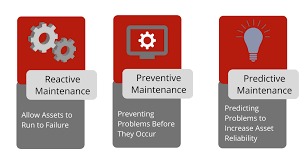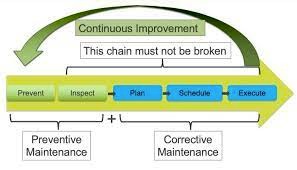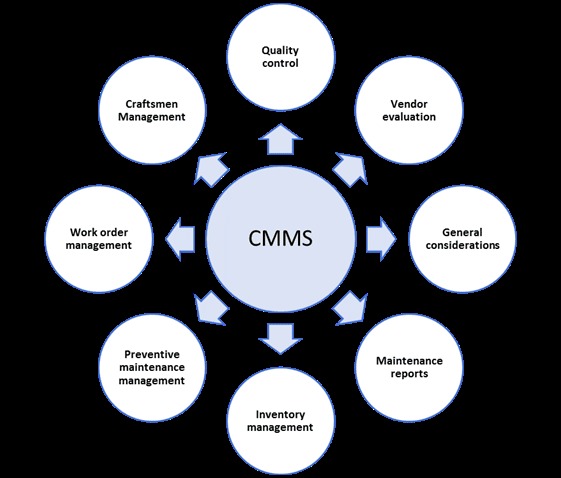6 Min Read


As many companies or organizations that manage physical assets know, maintaining equipment and critical assets for an extended period is a considerable undertaking. In theory, performing routine maintenance tasks on important assets may sound simple, but significant planning, scheduling, and action lies behind this effort.
Introducing… preventive maintenance – a maintenance strategy that focuses on regularly performing maintenance on important assets. As a maintenance strategy, preventive maintenance focuses on maintaining critical equipment and assets before equipment failure. We will discuss different types of preventive maintenance in the next section.
No matter the size of the business, implementing planned maintenance routines is essential to reduce costs, avoid costly repairs, extend asset lifespan, reduce equipment downtime, and ensure employee safety. However, before discussing the benefits of having a preventive maintenance program in more detail, let’s first discuss some of the maintenance strategies available to businesses.
What is Preventative Maintenance?
Preventive maintenance (or preventative) is not the only maintenance strategy available to companies. As mentioned, preventive maintenance focuses on maintaining and servicing assets/equipment before either breakdown.
Regular preventive maintenance tasks are performed on critical assets to prevent equipment failure. Examples of preventive maintenance thus include tasks such as routine inspections of assets, parts servicing/replacement, lubrication, and fluid changes.
In contrast to preventive maintenance, reactive maintenance focuses on maintaining or repairing an asset once it has broken down. This is why preventive maintenance is thought of as ‘proactive maintenance.’ In contrast, under a reactive maintenance ‘model,’ corrective maintenance is only implemented once equipment failure has occurred (hence the name ‘reactive maintenance’).
However, as we shall discuss soon, reactive maintenance should not be considered an inherently lousy maintenance strategy. In fact, the best maintenance strategies will include a mix of both preventive and reactive maintenance. But, preventive maintenance programs are still considered the superior option of the two.
Types of Preventative Maintenance
Depending on the assets at your company, different preventive maintenance schedules can be established by businesses for them.
One such type of preventive maintenance is called time-based preventive maintenance. Time-based maintenance is best for ‘bounded assets’ – such as fire safety equipment. As the name suggests, time-based preventive maintenance is conducted on assets after a certain period has elapsed.
By contrast, usage-based preventive maintenance is ‘triggered’ after an asset has performed a certain amount of ‘run time.’ For a vehicle fleet, this could be every 10,000 miles driven; for equipment, this could be every 5,000 hours of ‘run-time.’ Unlike the time-based approach, usage-based maintenance is often less rigid and is only performed as often as needed.
Another form of preventive maintenance is ‘condition-based (or condition) maintenance. This maintenance takes place once a particular set of conditions have been reached. Often, companies can monitor the performance of assets over time. Then, as the performance of assets begins to fall, maintenance teams can start their work on the assets.
Finally, predictive maintenance has become an increasingly important strategy over the previous years. Predictive maintenance involves the use of software to help create predictions for when assets might fail. Advanced predictive maintenance (also called prescriptive maintenance) will incorporate machine learning, advanced analytics, and artificial intelligence to help create predictive models and provide maintenance recommendations.
Significance of Preventative Maintenance
Formulating and implementing a successful preventive maintenance plan can significantly benefit your company. Usually, a preventive maintenance plan is implemented with the assistance of preventive maintenance software (this will be explained in greater detail below).
For a start, regular asset maintenance is vital for preventing unplanned downtime. For all businesses, unplanned downtime (and by extension, unplanned maintenance) is a state of affairs to be avoided as it eats up valuable production hours. Thus, with scheduled maintenance organized at regular intervals (as this is the hallmark of all types of preventive maintenance), you can keep your assets running for longer. Of course, this ensures that overall productivity remains unaffected throughout the year.
Establishing a preventive maintenance schedule is also crucial for reducing overall maintenance costs. Maintaining an asset over time (via preventive maintenance) is often cheaper than implementing corrective maintenance after it has broken down (or replacing the asset entirely).
The safety of your employees is also improved when preventive maintenance is prioritized. When assets and equipment are regularly maintained, maintenance personnel and technicians can locate any fault or hazards before they cause injury to your employees.
Finally, at a time when energy bills are quickly rising for many businesses, preventive maintenance can even help lower these! Consistently maintaining your equipment and assets will result in better operational efficiency. Of course, electrical systems and assets tend to use more energy when they are poorly maintained. Thus, by simply conducting regular maintenance operations, your business can reap significant financial rewards in the form of lower energy bills.
Potential Challenges Associated With Preventive Maintenance
If you can believe it, implementing preventive maintenance has potential drawbacks (and even disadvantages!). Let’s discuss each of these in turn.
Firstly, following and implementing a preventive maintenance schedule can be expensive. Organizations may need to hire new employees with the required skill sets; additionally, the cost of preventive maintenance software (which is instrumental for completing preventive maintenance) can be prohibitively expensive.
Additionally, organizing preventive maintenance can take considerable time for organizations that might not necessarily have it. Inspections, diagnostics, and corrections all take up time – so much so that many companies may decide to skip periodic maintenance altogether.
Finally, finding the optimal amount of maintenance activity that maintenance technicians should perform is surprisingly challenging. Some companies will struggle with implementing too much maintenance, while others will not conduct enough of it. Unfortunately, conducting preventive maintenance on your assets too often can see an explosion of unjustifiable costs.
To avoid too much maintenance, your company must strike a balance between reactive and preventive maintenance (with the scales still tipped in favor of preventive maintenance). This way, you’ll get the best from a preventive maintenance program without worrying that the costs are unnecessary!
Smarter Asset Tracking With NFC Tags
Learn more about how NonStop Suite's NFC Asset Tracking Solution can help your Enterprise streamline operations to new heights.
Get A Free Product Tour
How to Perform Preventive Maintenance Tasks Efficiently?
No matter the type of preventive maintenance your company has selected, the preventive maintenance process relies on creating sustainable short-term and long-term maintenance goals and a preventive maintenance checklist for your employees. Essentially, this checklist should detail to any maintenance technician or maintenance team how they can go about performing periodic maintenance.
To ensure preventive maintenance success (and maintenance tasks are performed efficiently), facility managers must first create a preventive maintenance workflow. This workflow should detail the technical aspects of all maintenance operations – such as where the assets are located, how often they need to be serviced, and who is responsible for servicing them.
During this stage, facility managers should gather data from the manufacturer’s manuals, record serial numbers and part numbers, and identify which spare parts are needed.
Following this, facility managers need to distribute maintenance checklists to maintenance technicians. As discussed above, these checklists must detail how technicians can maintain assets. During this stage, facility managers should provide the organization’s short-term and long-term maintenance goals; technicians should also be invited to provide their input as well.
Finally, maintenance technicians can begin their inspections (and, if needed, maintenance) of the company’s assets. Crucially, the maintenance process should be monitored by facility managers over time to see where the company can make improvements. Of course, the notes from preventive maintenance work orders and inspections should be on file and easily accessible. Again, this is something that preventive maintenance software can help with.
Use a Preventive Maintenance Software For The Creation of a Preventive Maintenance Program

There are different types of preventive maintenance software that businesses can use. Usually, companies can use a computerized maintenance management system (CMMS) solution or an Enterprise Asset Management (EAM) solution.
No matter which you use, both are advanced digital maintenance solutions that can revolutionize how your business conducts any preventive maintenance task. Moreover, with the help of a preventive maintenance solution, your company will reap all the benefits of preventive maintenance.
The most crucial feature of preventive maintenance software is that it enables remote access for maintenance teams. For example, facility managers can send the details of work orders via the software, meaning technicians can work on assets when in the field.
Additionally, as this software is hosted on a cloud, all asset data is in one centralized location. With essential data being in one place, technicians can access it (and provide updates) no matter where they are! Importantly, having this repository of data is vital for future maintenance operations.
With the cutting-edge Field Management Software (FMS) provided by IBM Maximo, it is easier for your organization to implement preventive maintenance. With technicians having instant access to inspection records and asset data, the need for bulky files and disorganized spreadsheets is over. Moreover, this software automatically alerts facility managers ahead of planned maintenance, meaning that any potential disruption to production cycles can be prepared for by businesses ahead of time. Of course, technicians can also use FMS provided by IBM Maximo to schedule maintenance for the future, thereby easing the coordination of your maintenance team.
Wrapping Up!
Finding the best preventive maintenance for your organization can be arduous. For this reason, your company should consult the NonStop Group, which can provide an innovative Enterprise Asset Management solution.
The NonStop Group has a wealth of experience helping clients in the manufacturing, transport, logistics, and oil & gas industries. The NonStop Group has introduced sophisticated electronic forms to replace paper forms and spreadsheets when assisting these clients. Additionally, with the NonStop Group’s innovative tagging system, the work history for any asset can be easily accessed by technicians. By simply scanning the asset tag attached to assets, maintenance technicians can access important work history data in seconds.
These are only some of the ways the NonStop Group can help streamline the maintenance process at your company. If you want these results and more for your company, contact the NonStop Group today!


